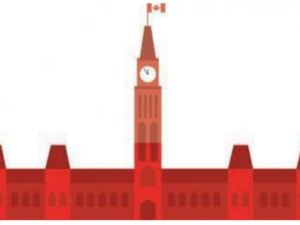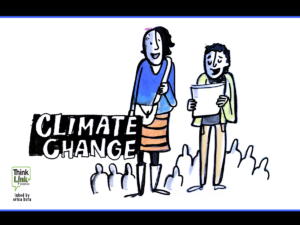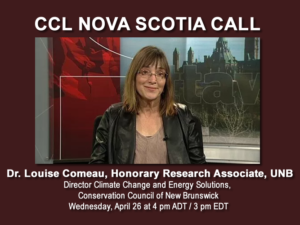Media Contact: Cathy Orlando, National Manager As the province considers its carbon pricing options, a growing number of experts and pundits are conferring with the Finance and Community Services Departments’ policy directors pointing them to and calling for a revenue neutral carbon pollution dividend to every citizen. The government of Nova Scotia is in the midst of holding public input sessions called “Let’s Talk Taxes” posing three “taxing” questions to citizens, which citizens in small group sessions discuss and return their points to the finance department for compilation and consideration. The number two question asks if the province should introduce a price on carbon. At the Halifax session, a consistent “yes” to carbon pricing was tabulated from the groups’ chart paper notes displayed around the room. The November 2014 Nova Scotia Tax and Regulatory Review, “Charting a Path for Growth” by Laurel Broten officially introduced the possibility of a carbon tax to the province’s finance minister, Diana Whalen. On Page 51, “Implement a Tax on Pollution,” she concluded that: “Nova Scotia should phase in the implementation of a pollution tax regime over the next ten years. The tax should be revenue neutral to the province, with all available revenue earmarked to provide generous support to low- income families as well as overall corporate and personal income tax relief.” Nova Scotian intellectuals and journalists have been promoting a price on pollution for some years. In 2008, internationally reputable economist, known for his work on poverty, Dr. Lars Osberg, chair of Dalhousie University’s Economics Department wrote a paper, “Have Most Canadians Already Met their Kyoto Obligations?—Trends in the CO2 Content of the Consumption and the Role of Income Inequality.” He prefaces the article: The Kyoto Protocol, which Canada signed in 1997, and ratified in 2002, committed Canadians to a collective obligation—reducing greenhouse gases (GHG) emissions to 6% below 1990 levels by 2008-2012. (The U.S. target of a 7% reduction was signed but never ratified.). Total GHG emissions by both nations have in fact increased substantially. But the majority of Americans and Canadians have seen little change in the real value of their consumption, which is now significantly more energy-efficient, per dollar of spending, than it was in 1990. Many Canadians and Americans have in fact therefore already reduced their own household production of greenhouse gases by as much, or more, than the Kyoto Protocol would require. This paper therefore asks: What individual obligations correspond to Canada’s collective commitment? Who has been responsible for the overall increase in Canada’s GHG emission? Who should now pay for reduced GHG concentrations? Osberg’s third argument in the paper: “that an escalating carbon tax which is fully refunded as a demo-grant to all citizens offers the best practical hope for efficient and equitable climate change policy.” This provides a sound academic solution to back up Minister Whalen’s regularly issued statement during the sessions—that a price on pollution must not hurt the low income households. Dr. Osberg offers that a carbon fee with a demo-grant (dividend) is the best common sense answer. Well-respected columnist, Ralph Surrette in the November 28th edition of the Chronicle-Herald wrote: “In ten years, carbon taxes, mostly revenue-neutral, will be universal — even the oil companies are resigned to that).” and “B.C. has been reducing its energy use faster than the national average, and its economy has not suffered, contrary to the usual jeremiads.” (August 22, 2014 edition) Recently has the provincial government endeavoured, by way of its commission (The Broten Report), to open the books for review. Whether they expected an official stamp of approval for a B.C. type carbon tax is open to speculation but that is what the minister received. But Nova Scotia already has an assessment and recommendation in Lars Osberg’s paper (above) for this type of price on carbon and, since he has lived and examined this region for decades while also being internationally published and respected, his preference for a carbon tax with a fully-refunded “demo-grant” (as compard with B.C.’s use of income tax reduction as the carrot offered to citizens) needs to be seriously considered as a better choice. The fact of Osberg’s work in anti-poverty lends more weight to the problem than Broten’s (who recently moved to N.S. from Ontario) in a province with 50% of its citizens at the $30,000 or less income bracket. It is clear that Broten favours a B.C. type carbon tax but Nova Scotia has reason and proof to study seriously the carbon fee and dividend proposal based on Osberg’s highlighting of its benefit to lower income citizens. This fact was substantiated in an article, “Higher, More Progressive Taxes Would Yield Benefits” by “Affordable Energy Coalition” member and Halifax Herald writer, Brian Gifford: “Given the empirical evidence, we really are at a point where cash-strapped jurisdictions such as Nova Scotia must justify why they are not leveraging the tax system to alleviate poverty and broaden social supports. We cannot afford not to commit to serious social investments to achieve greater equality and economic growth.” Carbon fee and dividend is a practical example of applying the principle Gifford outlines. It places a steadily-rising fee on the carbon dioxide content of fossil fuels at the well, mine or port of entry. The fee increases steadily each year with the intention of making clean energy cheaper than fossil fuels within a decade. The revenue from that fee is returned to households in equal shares in the form of a dividend cheque. Under this plan 66% percent of Canadian households would break even or receive more in their dividend cheque than they would pay for the increased cost of energy, thereby protecting the poor and middle class from the impacts of the rising fee. A predictably increasing carbon price will send a clear market signal which will unleash investments in the new clean-energy economy. A study from Regional Economic Models, Inc. (REMI) – released last summer by Citizens’ Climate Lobby – looked at the impact of a fee starting at $10 per tonne of CO2 that rose $10 per tonne each year in the United States. In the study, all the revenue from the fee was divided equally among all households and returned as monthly payments. After 20 years, CO2 emissions were cut in half and 2.8 million jobs were added to the American economy. The job growth comes primarily from the stimulus effect of recycling carbon fee revenue into the pockets of people who are likely to spend the money. Carbon fee and dividend is sometimes called carbon tax and dividend. In a November 15th an op. ed. in the Chronicle-Herald, “Canada Must Set Carbon-Fee Policy”, the national manager and local group leader for Citizens’ Climate Lobby put forth a “simpler [than a Cap and Trade plan] market-based approach: implementing a steadily rising fee on carbon-based fuels that returns all revenue collected to Canadian households.” While in the Globe and Mail and Toronto Star journalists have urged Ontario to look to B.C. for its carbon pricing model (the right leaning National Post even conceding that a carbon tax would be the most efficient way to reduce greenhouse gas emissions), climate advocates from Citizens’ Climate Lobby Halifax , the Affordable Energy Coalition and other Nova Scotian climate committees are introducing “fairness” into the “pricing pollution discussion.” As Lars Osberg points out in his January 2015 paper, “The Carbon Tax and Dividend (CTD) – A Proposal for Sustainability and Fairness”: “But lower and middle income Canadians have seen their real incomes stagnate for several decades now. They feel increasingly pressured financially and they are understandably mistrustful of promises that a new tax, which visibly adds to their day-to-day cost of living will be somehow offset by invisible benefits sometime in the future. Unless there is a clear way of counteracting the argument, a carbon tax proposal will always be vulnerable to the Harper government’s message that it is an attack on “the hard working Canadian middle class”. The CTD proposal is a straightforward way of showing this is wrong–the CTD would improve both environmental sustainability and economic fairness.” Economists and political pundits from either side of the political spectrum have also announced their preference for a revenue neutral carbon pricing system including Preston Manning, a member of the new Canadian Ecofiscal Commission, Dr. David Robinson, Director of Director of the Institute for Northern Ontario Research and Development and Green Party candidate, and Jeff Rubin, economist and author. Recently, Nicholas Rivers, Chairholder, Canada Research Chair in Climate and Energy Policy, released a paper called The case for a carbon tax in Canada, outlining how carbon taxes are effective, efficient, easy to design and transparent, and even popular with the public. The N.S. Department of Community Services is also studying carbon fee and dividend after CCL volunteers introduced the plan to Brenda Murray, their policy director. An integration of these two department’s tax application was also a recommendation in The Broten Report. In November 2014, volunteers from Citizens’ Climate Lobby (CCL) Halifax, in a meeting with Finance Minister, the Honourable Diana Whalen listened appreciatively and enthusiastically as she stated that any carbon pricing plan introduced into Nova Scotia must not hurt the “less fortunate.” Her comment is further corroborated when we realize that the lower and middle income citizens pay more than their share for carbon pollution. Lars Osberg writes “If we recognize that it is consumption which ultimately drives GHG emissions, who then is really responsible for the increase in global concentrations of greenhouse gases…the poor and the middle class Canadians and Americans of 1990 are not the people who have been responsible for the rising consumption that drives increased global concentrations of greenhouse gases. Nevertheless, under some proposals, the cost of policies to reduce greenhouse gas concentrations will be borne disproportionately by the less well off…” The volunteers were able to reassure the minister that the carbon fee and dividend would do better than that—take a small bite out of poverty. CCL Volunteers are meeting with policy directors this month. The Nova Scotia Business Inc. website states that Nova Scotia has legislated targets for 25% renewable electricity by 2015 and a goal for 40% renewable electricity by 2020. The website summarizes the potential in various clean energy technologies and lists businesses operating now in some of these areas. As Nova Scotia’s clean technology industry attracts considerable international attention, its accessibility to natural resources, such as wind, tidal and solar, enables the province to engage in significant research and development activities as well as large scale projects. According to Analytica Advisors, Canada’s clean technology sector, currently an $11.3 billion industry, has the potential to grow to $50 billion by 2022 and represent two percent of the global market share. Clean technology could transform Canadian industrial practices if the Canadian and provincial governments legislates policies that optimize its growth. Other countries have taken notice, buying environmentally-friendly Canadian technologies that help reduce and recycle solid waste, improve efficiencies and reduce our reliance on fossil fuel and petro-products. Approximately 74 percent of Canadian clean technology companies are exporters, with 42 percent of export sales going to non-US countries. Without domestic support, Canadian clean technology companies are in danger of being bought out by international players, taking Canadian innovation and jobs with them. While Canadian clean technology enjoys strong market diversification overseas, it struggles to compete domestically. One challenge is the price of carbon-based energy, which is relatively cheap in Canada compared to many countries. A fee on carbon that rises annually will send a market signal to invest in technologies that help reduce carbon emissions and clean up the environment. Between 2008, when BC legislated a revenue neutral carbon tax, and 2010, the province’s clean technology sector’s sales grew by 48 percent. In 2012, BC was home to 22 percent of clean technology companies in Canada. It would be wise for Nova Scotia to look beyond the British Columbia made-in-Canada solution to pricing carbon. If Nova Scotia implemented a superior Carbon Fee and Dividend, similar results would occur, perhaps even more so because the cost of living in Nova Scotia is less than in B.C. While Stephane Dion’s failed Carbon Shift is often cited as a reason for politicians to avoid carbon taxes, the temperature is changing regarding public acceptance. BC’s former premier, Gordon Campbell was re-elected following the introduction of the province’s carbon tax, which has enjoyed strong support from British Columbians according to polls. The most recent poll, from Abacus Data, shows that 69 percent of Canadians feel that Canada should introduce a policy that provides a financial incentive to reduce carbon emissions over time. Fifty-nine percent would like to see increased taxes on activities and products that produce higher emissions, while 78 percent support lower taxes on activities and products that produce lower emissions. “Here’s your cheque!” Carbon Fee and Dividend offers Nova Scotia a solution that supports and will foster public acceptance of a carbon tax through the rising fee on fossil fuels and money returned to households through dividend cheques. Nova Scotia will also benefit from a growing clean technology sector that offers high quality jobs, stimulated by the rising fee on fossil fuels. Citizens’ Climate Lobby (CCL) is a growing organization of more than 250 local volunteer chapters in Canada, the U.S., and worldwide that are pressing for progressive climate legislation. Currently, CCL citizen volunteers lobby representatives to support the carbon pricing mechanism, Carbon Fee and Dividend, and to end subsidies to fossil fuel companies. The former puts a direct fee on carbon-based fuels at the source, providing a market signal to invest in clean energy technology, while returning the fee’s revenue to citizens in the form of regular payments. CCL was founded in 2007 in the U.S. by Marshall Saunders, a recipient of the Grameen Foundation Humanitarian Award. Visit: citizensclimatelobby.ca ADDITIONAL RESOURCES:
cathy@citizensclimatelobby.ca, 705-929-4043
Citizens’ Climate Lobby Canada, 80 Elm Street, Sudbury, ON P3C 1T2
February 11, 2015Nova Scotia can be a cutting edge world leader in carbon reductions with a socially ‘just’ carbon pricing system called Carbon Fee and Dividend
CARBON PRICING ON THE HORIZON FOR NOVA SCOTIA:
CARBON FEE AND DIVIDEND a.k.a. CARBON TAX AND DIVIDEND

SUPPORT FOR REVENUE NEUTRAL CARBON TAXES
LOBBYING, CARBON PRICING AND THE LESS FORTUNATE

NOVA SCOTIA’S CLEAN TECH INDUSTRY

PUBLIC SUPPORT
About Citizens’ Climate Lobby
Nova Scotia Tax and Regulatory Report (November 2014) Laurel Broten
Have Most Canadians Already Met their Kyoto Obligations (June 2008) Lars Osberg
Nova Scotia can be a cutting edge world leader in carbon reductions with a socially just carbon pricing system called Carbon Fee and Dividend
Home » CCL Canada News » Nova Scotia can be a cutting edge world leader in carbon reductions with a socially just carbon pricing system called Carbon Fee and Dividend
Nova Scotia can be a cutting edge world leader in carbon reductions with a socially just carbon pricing system called Carbon Fee and Dividend
Posted on February 10, 2015 in Media Release






